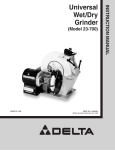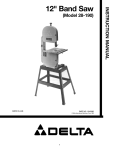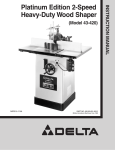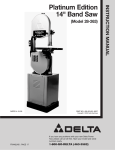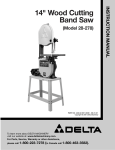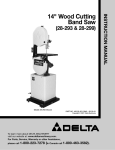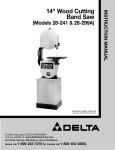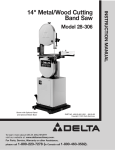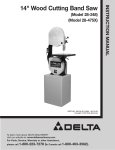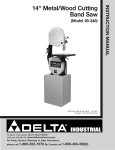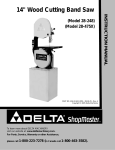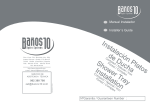Download Delta 28-280 Instruction manual
Transcript
(Model 28-280) The Serial No./Model No. plate is attached to the right side of the base casting. Locate this plate and record the Serial No. and Model No. in your manual for future reference. SERIAL NO.___________________________________ MODEL NO. __________________________________ DATED 1-15-96 PART NO. 426-02-651-0023 ©Delta International Machinery Corp. 1996 INSTRUCTION MANUAL 14" Wood Cutting Band Saw SAFETY RULES Woodworking can be dangerous if safe and proper operating procedures are not followed. As with all machinery, there are certain hazards involved with the operation of the product. Using the machine with respect and caution will considerably lessen the possibility of personal injury. However, if normal safety precautions are overlooked or ignored, personal injury to the operator may result. Safety equipment such as guards, push sticks, holddowns, featherboards, goggles, dust masks and hearing protection can reduce your potential for injury. But even the best guard won’t make up for poor judgment, carelessness or inattention. Always use common sense and exercise caution in the workshop. If a procedure feels dangerous, don’t try it. Figure out an alternative procedure that feels safer. REMEMBER: Your personal safety is your responsibility. This machine was designed for certain applications only. Delta Machinery strongly recommends that this machine not be modified and/or used for any application other than that for which it was designed. If you have any questions relative to a particular application, DO NOT use the machine until you have first contacted Delta to determine if it can or should be performed on the product. DELTA INTERNATIONAL MACHINERY CORP. MANAGER OF TECHNICAL SERVICES 246 ALPHA DRIVE PITTSBURGH, PENNSYLVANIA 15238 (IN CANADA: 644 IMPERIAL ROAD, GUELPH, ONTARIO N1H 6M7) WARNING: FAILURE TO FOLLOW THESE RULES MAY RESULT IN SERIOUS PERSONAL INJURY It’s safer than using your hand and frees both hands to operate tool. 1. FOR YOUR OWN SAFETY, READ INSTRUCTION MANUAL BEFORE OPERATING THE TOOL. Learn the tool’s application and limitations as well as the specific hazards peculiar to it. 15. DON’T OVERREACH. Keep proper footing and balance at all times. 2. KEEP GUARDS IN PLACE and in working order. 16. MAINTAIN TOOLS IN TOP CONDITION. Keep tools sharp and clean for best and safest performance. Follow instructions for lubricating and changing accessories. 3. ALWAYS WEAR EYE PROTECTION. 4. GROUND ALL TOOLS. If tool is equipped with three-prong plug, it should be plugged into a three-hole electrical receptacle. If an adapter is used to accommodate a two-prong receptacle, the adapter lug must be attached to a known ground. Never remove the third prong. 17. DISCONNECT TOOLS before servicing and when changing accessories such as blades, bits, cutters, etc. 18. USE RECOMMENDED ACCESSORIES. The use of accessories and attachments not recommended by Delta may cause hazards or risk of injury to persons. 5. REMOVE ADJUSTING KEYS AND WRENCHES. Form habit of checking to see that keys and adjusting wrenches are removed from tool before turning it “on.” 19. REDUCE THE RISK OF UNINTENTIONAL STARTING. Make sure switch is in “OFF” position before plugging in power cord. 6. KEEP WORK AREA CLEAN. Cluttered areas and benches invite accidents. 20. NEVER STAND ON TOOL. Serious injury could occur if the tool is tipped or if the cutting tool is accidentally contacted. 7. DON’T USE IN DANGEROUS ENVIRONMENT. Don’t use power tools in damp or wet locations, or expose them to rain. Keep work area well-lighted. 21. CHECK DAMAGED PARTS. Before further use of the tool, a guard or other part that is damaged should be carefully checked to ensure that it will operate properly and perform its intended function – check for alignment of moving parts, binding of moving parts, breakage of parts, mounting, and any other conditions that may affect its operation. A guard or other part that is damaged should be properly repaired or replaced. 8. KEEP CHILDREN AND VISITORS AWAY. All children and visitors should be kept a safe distance from work area. 9. MAKE WORKSHOP CHILDPROOF – with padlocks, master switches, or by removing starter keys. 22. DIRECTION OF FEED. Feed work into a blade or cutter against the direction of rotation of the blade or cutter only. 10. DON’T FORCE TOOL. It will do the job better and be safer at the rate for which it was designed. 23. NEVER LEAVE TOOL RUNNING UNATTENDED. TURN POWER OFF. Don’t leave tool until it comes to a complete stop. 11. USE RIGHT TOOL. Don’t force tool or attachment to do a job for which it was not designed. 12. WEAR PROPER APPAREL. No loose clothing, gloves, neckties, rings, bracelets, or other jewelry to get caught in moving parts. Nonslip footwear is recommended. Wear protective hair covering to contain long hair. 24. DRUGS, ALCOHOL, MEDICATION. Do not operate tool while under the influence of drugs, alcohol or any medication. 13. ALWAYS USE SAFETY GLASSES. Wear safety glasses. Everyday eyeglasses only have impact resistant lenses; they are not safety glasses. Also use face or dust mask if cutting operation is dusty. 26. WARNING: The dust generated by certain woods and wood products can be injurious to your health. Always operate machinery in well ventilated areas and provide for proper dust removal. Use wood dust collection systems whenever possible. 25. MAKE SURE TOOL IS DISCONNECTED FROM POWER SUPPLY while motor is being mounted, connected or reconnected. 14. SECURE WORK. Use clamps or a vise to hold work when practical. ADDITIONAL SAFETY RULES FOR BAND SAWS 1. ADJUST the upper guide about 1/8 above the material being cut. 2. MAKE SURE that blade tension and blade tracking are properly adjusted. 3. STOP the machine before removing scrap pieces from the table. 4. ALWAYS keep hands and fingers away from blade. 5. CHECK for proper blade size and type. 6. DO NOT attempt to saw stock that does not have a flat surface, unless a suitable support is used. 7. HOLD material firmly and feed into blade at a moderate speed. 8. TURN OFF machine if the material is to be backed out of an uncompleted cut. 9. MAKE “release” cuts before cutting long curves. 10. ADDITIONAL INFORMATION regarding the safe and proper operation of this product is available from the National Safety Council, 1121 Spring Lake Drive, Itasca, IL 60143-3201 in the Accident Prevention Manual for Industrial Operations and also in the Safety Data Sheets provided by the NSC. Please also refer to the American National Standards Institute ANSI 01.1 Safety Requirements for Woodworking Machinery and the U.S. Department of Labor OSHA 1910.213 Regulations. 2 UNPACKING AND CLEANING Carefully unpack the band saw and all loose items from the shipping container. Remove the protective coating from the machined surfaces of the band saw. This coating may be removed with a soft cloth moistened with kerosene (do not use acetone, gasoline or lacquer thinner for this purpose). After cleaning, cover all unpainted surfaces with a good quality paste wax. ASSEMBLY STAND If you purchased your band saw complete with stand and electricals, the stand is shipped top down inside the shipping container with the motor mounted to the inside top of the stand. The on/off switch is wired to the end of the power cord. The motor must be removed from the inside top of the stand and reassembled to the horizontal mounting bars insede the stand as follows: 1. Remove the stnad (A) from the shipping container being careful not to crimp the switch cord which extends through the top of the stand. NOTE: Set the stand on several blocks of wood to raise the stand off the floor surface. 2. Remove paner (B) Fig. 1, from stgand (A) by removing two screws (C) and loosening two screws (D). Remove panel on opposite side of stand in the same manner. Fig. 1 Remove two mounting screws, one of which is shown at (E) Fig. 2, that are holding motor (F) to the top of stand (A). IMPORTANT: DO NOT REMOVE CABLE TIE (G) THAT IS HOLDING SWITCH CORD (H) TO VERTICAL MOUNTING BAR (J) UNLESS YOU ARE USING THE ACCESSORY 28894 HEIGHT ATTACHMENT ON THE BAND SAW. THIS CABLE TIE (G) WILL KEEP THE SWITCH CORD (H) FROM CONTACTING THE MOTOR PULLEY OR BELT DURING OPERATION. Fig. 2 ASSEMBLING MOTOR TO STAND 1. To make the motor assembly easier, turn stand (A) Fig. 2A, on its side with two horizontal bars (B) down as shown. 2. Position motor (C) Fig. 2A, on two horizontal suport bars (B) as shown, and fasten with four 3/4" long carriage bolts, two of which are shown at (D), and four flanged nuts. IMPORTANT: MAKE CERTAIN MOTOR SHAFT (e) IS ON THE SAME SIDE OF THE STAND AS THE LARGE OPENING IN THE TOP OF THE STAND BEFORE TIGHTENING CARRIAGE BOLTS (D). Further motor alignment will be necessary after band saw is fastened to stand. 3. Carefully turn the stand right side up. Fig. 2A 3 4 ASSEMBLING BELT AND PULLEY GUARD Assemble the belt and pulley guard (A) to the top of the stand, as shown in Fig. 6, using the two 1/4-20 x 1/2 hex head screws, washers and nuts (B). ASSEMBLING SWITCH If you purchased your band saw complete with stand and electricals, you received a switch mounted in a switch box and a cord set connected to the motor. Assemble the switch to the band saw arm as follows: Fig. 6 1. MAKE CERTAIN THE BAND SAW IS DISCONNECTED FROM THE POWER SOURCE. 2. CAUTION: THE ON/OFF SWITCH-TO-MOTOR CORD (F) FIG. 7, IS TIED TO VERTICAL MOUNTING POST (G) OPPOSITE THE MOTOR PULLEY. THIS CABLE TIE (H) PREVENTS THE SWITCH-TO-MOTOR CORD (F), FROM CONTACTING THE BELT OR MOTOR PULLEY DURING OPERATION. IMPORTANT: DO NOT REMOVE THIS CABLE TIE UNLESS YOU ARE USING THE ACCESSORY #28-984 HEIGHT ATTACHMENT WITH THE BAND SAW. 3. Remove two outer hex nuts and lock washers (A) Fig. 8, from the two screws extending out from the back of the switch box (B). 4. Insert two screws (C) Fig. 9, located on back of switch box, into two holes (D) located in the band saw arm. Fig. 7 B A D C F Fig. 8 Fig. 9 5 5. Fasten the switch box to the band saw arm using two nuts and lockwashers (A) Fig. 10, which were removed in STEP 3. A Fig. 10 6. Remove screw and cable clamp (E) Fig. 11, from lower arm of band saw. 7. Insert switch cord (F) Fig. 12, into clamp (E) which was removed in STEP 6, and fasten switch cord (F) to band saw as shown. IMPORTANT: CHECK AND MAKE CERTAIN THE ON/OFF SWITCH-TO-MOTOR CORD (F) FIG. 7, IS NOT CONTACTING MOTOR PULLEY OR BELT. ADJUST CORD (F) FIG. 7, IF NECESSARY, THEN TIGHTEN CABLE TIE (H). E Fig. 11 STARTING AND STOPPING SAW To start the saw, press the “START” button (K) Fig. 12. To stop the saw, press the “STOP” button (L) Fig. 12. K L F E Fig. 12 LOCKING SWITCH IN THE OFF POSITION We suggest that when the saw is not in use, the switch be locked in the “OFF” position using a padlock (M) Fig. 13, through the switch plate and “START” button (K) as shown. K M Fig. 13 6 TABLE INSERT Place table insert (A) Fig. 14, in the hole provided in the table, making sure the pin (B) in the table engages one of the indents in the table insert. Fig. 14 TILTING THE TABLE The table on your band saw can be tilted 45 degrees to the right and 10 degrees to the left. To tilt the table, loosen the two lock knobs (A) Fig. 15, tilt the table to the desired angle and tighten the two lock knobs (A). Fig. 15 ADJUSTING TABLE STOP The band saw is equipped with an adjustable table stop (A) Fig. 16, that allows the table to be set perfectly at 90 degrees with the blade. Tilt the table to the left until the table stop (A) Fig. 16, contacts the bottom of the table. Place a square on the table and against the blade as shown in Fig. 14, and check to see if the blade is 90 degrees to the table surface. If an adjustment is necessary, proceed as follows: 1. Tilt the table slightly to the right and tighten table lock knobs. 2. Turn adjustment nut (B) Fig. 16, right or left as necessary to raise or lower table stop (A). IMPORTANT: Certain models of band saws will have an additional locknut assembled to the end of the table stop (A) Fig. 16, directly under casting (C). Loosen locknut and turn adjustment nut (B) right or left as needed to raise or lower the table stop (A). Tighten locknut after adjustment is made. Fig. 16 3. Lower the table and make certain the table is 90 degrees to the blade as shown in Fig. 17. 4. It is necessary to remove the adjustable table stop (A) Fig. 16, when tilting the table to the left. Fig. 17 7 ADJUSTING BLADE TENSION On the back of the upper wheel slide bracket, there is a series of graduations. These indicate the proper tension for various widths of blades. With the blade on the wheels, turn the knob (A) Fig. 18, to raise or lower the wheel, until the red fiber washer (B) is in line with the proper graduation for the size of blade being used. The graduations will be found correct for average work, and are not affected by rebrazing of the saw blade. We urge you to use these graduations until you have become familiar enough with the operation of the Band Saw to vary the tension for different kinds of blades or work. Over-straining is a common cause of blade breakage and other unsatisfactory blade performance. Release the tension when the machine is not in use. Fig. 18 TRACKING THE BLADE IMPORTANT: Before tracking the blade, make sure the blade guides and blade support bearings are clear of the blade so as not to interfere with the tracking adjustment. After tension has been applied to the blade, revolve the wheels slowly forward by hand and watch the blade (A) Fig. 19, to see that it travels in the center of the upper tire. If the blade begins to creep toward the front edge, loosen the wing nut (B) Fig. 20, and tighten the thumb screw (C). This will tilt the top of the wheel toward the back of the machine and will draw the blade toward the center of the tire. If the blade creeps toward the back edge, turn the thumb screw in the opposite direction. Adjust the thumb screw (C) Fig. 20, only a fraction of a turn at a time. NEVER TRACK THE BLADE WHILE THE MACHINE IS RUNNING. After the blade is tracking in the center of the tires, tighten the wing nut (B) Fig. 20. Fig. 19 Fig. 20 8 ADJUSTING UPPER BLADE GUIDE ASSEMBLY The upper blade guide assembly (A) Fig. 21, should always be set as close as possible to the top surface of the material being cut by loosening lock knob (B) and moving the guide assembly (A) to the desired position. Fig. 21 The upper blade guide assembly should also be adjusted so that the blade guides (A) Fig. 22, are flat with the blade. If an adjustment is necessary, loosen screw (B) and rotate the complete guide assembly (C) until the blade guides are flat with the blade. Fig. 22 9 ADJUSTING UPPER BLADE GUIDES AND BLADE SUPPORT BEARING The upper blade guides and blade support bearings are adjusted only after the blade is tensioned and tracking properly. To adjust proceed as follows: 1. The upper blade guides (A) Fig. 23, are held in place by means of the set screws (B). Loosen the set screws (B) to move the guides (A) as close as possible to the side of the blade, being careful not to pinch the blade. Then tighten the screws (B). 2. The guides (A) Fig. 23, should then be adjusted so that the front edge of the guides are just behind the “gullets” of the saw teeth. The complete guide block bracket can be moved in or out by loosening thumb screw (C) and turning knurled knob (D) Fig. 23. When guides (A) are set properly, tighten thumb screw (C). Fig. 23 3. The upper blade support bearing (E) Fig. 23, prevents the blade from being pushed too far to the back which could damage the set in the saw teeth. The support bearing (E) should be set 1/64 behind the blade by loosening thumb screw (F) and turning knurled knob (G) to move the support bearing (E) in or out. 4. The blade support bearing (E) should also be adjusted so the back edge of the blade overlaps the outside diameter of the ball bearing by about 1/16 . The bearing (E) is set on an eccentric and to change position remove screw (H) and bearing (E) Fig. 23. Loosen thumb screw (F), back out screw (G) and re-position shaft that bearing (E) is attached to. ADJUSTING LOWER BLADE GUIDES AND BLADE SUPPORT BEARING The lower blade guides and blade support bearing should be adjusted at the same time as the upper guides and bearing as follows: 1. Loosen the two screws (A) Fig. 24, and move the guides (B) as close as possible to the side of the blade, being careful not to pinch the blade. Then tighten screws (A). 2. The front edge of the guide blocks (B) should be adjusted so they are just behind the “gullets” of the saw teeth by turning the knurled knob (C) Fig. 24. Fig. 24 3. The lower blade support bearing (D) Fig. 24, should be adjusted so it is about 1/64 behind the back of the blade by turning the knurled knob (E). 10 11 12













